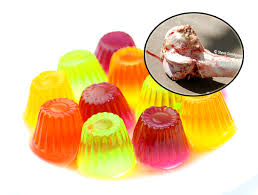Gelatin is a colorless, translucent, odorless, and a rather tasteless substance used in many food products. Many people wonder what makes up the gelatin. It is a common question, and many people are actually quite confused about it. The simple answer to your question, is that it is made by boiling of cartilage, skin, and bones of animal. In most cases, Gelatin is made using the leftover of the stuff meat industries, such as cattle bones and pork skins. The substance is also used in photography, pharmaceuticals, and cosmetic manufacturing. You will most often find it in gummy candy, as well as other products, including gummy bears, marshmallows, ice cream, gelatin dessert, and yogurt as well. Household gelatin is available in the form of granules, sheets, and powder.
What Is Gelatin Made Of?
 Gelatin is basically a protein obtained mainly by boiling tendons, skin, bones, and ligaments with water. It is usually obtained from pigs or cows, but the gelatin in Jell-O is almost always from pigskin. It is an irreversibly hydrolyzed form of collagen and common foods that contain it are candy corn, trifles, gelatin desserts, and confections such as gummy bears, peeps, jelly babies, and fruit snacks.
Gelatin is basically a protein obtained mainly by boiling tendons, skin, bones, and ligaments with water. It is usually obtained from pigs or cows, but the gelatin in Jell-O is almost always from pigskin. It is an irreversibly hydrolyzed form of collagen and common foods that contain it are candy corn, trifles, gelatin desserts, and confections such as gummy bears, peeps, jelly babies, and fruit snacks.
It is worth mentioning that products containing gelatin aren't suitable for vegetarians, but there is a product known as "agar" that is called "gelatin" but is safe for vegetarians for use because it is made using seaweeds.
The Manufacturing Process of Gelatin
Now, you have some idea about, "what is gelatin made of?" It's time now to have a closer look at the complete manufacturing process. It is important first to know about the raw materials used during the manufacturing process. The list includes animal skins, bones, and tissues usually obtained from slaughterhouses. It is important to use sodium carbonate or caustic lime to extract bacteria and minerals from the animal parts. The process will also use flavorings, sweeteners, and colorings. Here's the systematic information about the manufacturing process:
1. Inspection and Cutting
It all starts by inspecting the animal parts for quality. The tissues, bones, and skins are then chopped using a machine.
2. Degreasing and Roasting
High-pressure water sprays are used to wash the chopped animal parts. They are then soaked in hot water to degrease. This reduces the fat content to 2% or so. The parts then move to an industrial dryer for roasting – they are roasted for half an hour at 200 degree Fahrenheit.
3. Acid and Alkaline Treatment
In the next step, the animal parts are soaked in some type of acid or alkaline solution for about five days. This process ensures no bacteria and minerals are left on the animal parts. This also facilitates the process of collagen release. The acid wash is usually around the pH level of less than 1.5, whereas the alkaline wash has a pH level of above 7.
4. Boiling
All the pieces of tissues, bones, and skin then go into large aluminum extractors for boiling in water. The workers can draw off the liquid using a tube that runs from the extractor. Flash heating is the process used for the sterilization of the liquid – it is carried out at 140 degree Celsius for four seconds only.
5. Evaporating and Grinding
The liquid then moves through filters to separate tissue, bone, and skin that may still be there. The liquid then moves to the evaporators where it is separated from the solid gelatin. It then moves to the next machine where it is pressed into sheets. Sometimes, it is passed through a grinder to turn into a fine powdery form.
6. Coloring and Flavoring
If the gelatin is to be used in the food industry, different types of sweeteners, colorings, and flavorings are also added in the end before packaging, which is an automated process.
